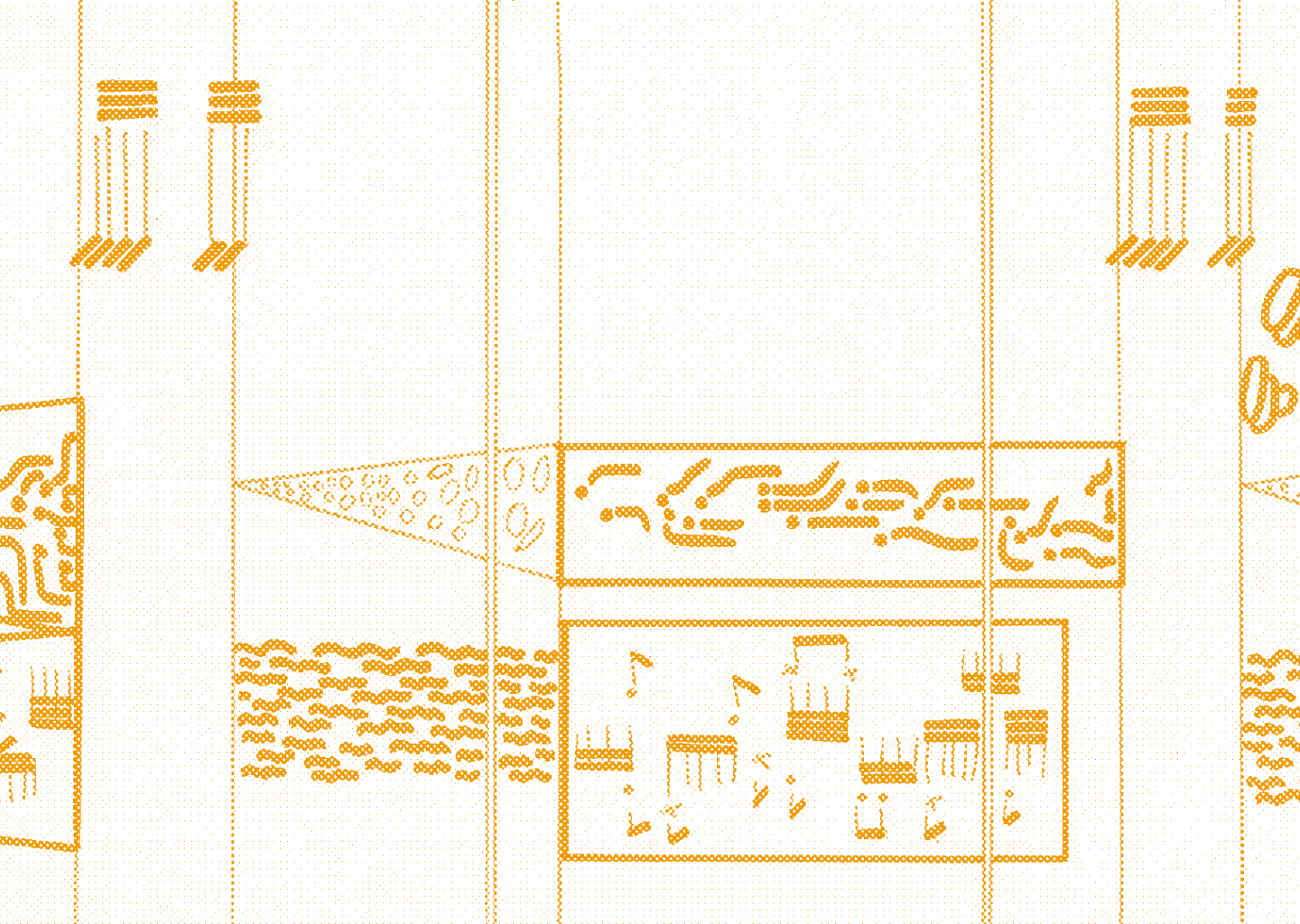
Music
CHAPTER 1 / INTRODUCTION
The section “Make your own opera” is aimed at students within and without the school setting, the educational community, and all those who like opera and the performing arts in general and would like to dare to create and stage their own performance. It is not a guide containing concrete steps or methodologies you need to follow to make your own show; “Make your own opera” is rather a source of inspiration, a section offering information that can surely be useful to you throughout the process, a section that aspires to make you feel creative without being preoccupied with whether or not you have the appropriate space, human resources or means. It is an educational tool that you can use for prearranged school celebrations – by implementing specific chapters of the provided material –, a big final presentation at the end of the school year, a performance you want to stage with your class, or even for your classes as part of the curriculum, starting from just one chapter. The stage that is hidden in your class is waiting for you to reveal it.
So make your own opera performance, and don’t get scared off by the title. Remember that opera constantly transforms and has a lot to teach you!
In this chapter we will explore ideas on how to create music, and more specifically, how to create a musical environment by producing original music, processing and employing known musical pieces or themes, improvising and experimenting with sounds of the environment and objects, but also by implementing other ideas that may arise during the creative process.
Have you ever wondered what opera would be like without music?
The answer is very simple and expected – we’re, of course, talking about theatre. However, if we want to understand the role of music in an opera work, but also the birth, the emergence of this genre, we just need to go back to something very simple, the connection between these two art forms. As you can find out in the chapter “The birth of opera”, opera was born through the discussion about how language could be connected to music, and how ancient Greek drama works could be revived with a musical accompaniment. It was through these ideas, therefore, and the experimentation with them, that this great chapter of the performing arts, opera, emerged.
In opera, there are the sung parts (arias), parts that focus more on rhythmic recitation (recitativos), and orchestral parts (overtures, intermezzos) [see the chapter “Genres of opera and opera parts”]. All of the above form the story of every opera work and contribute to the dramaturgy, that is, to achieving a better representation of the story for the audience. However, as we also mentioned in the chapter on Text, over the course of time and as the genre evolved, composers have introduced into their works electronic instruments and instruments that don’t belong to the orchestra, sounds of objects, sounds of the environment and the place where the story unfolds (soundscapes), musical collages made of excerpts from earlier works and new original music pieces, and many more elements. We will try to do something similar here, drawing inspiration from different music production options, with the goal of telling a story through the synergy of words and music.
Let’s see below some possible ways to do that:
- Using musical excerpts from known operas
- Songwriting (with the help of educators or fellow-pupils who know musical notation)
- Creating soundscapes – designing sound environments
- Composing music through digital programmes
CHAPTER 2 / KIND REMINDER
Before, however, you move on to defining the musical environment and creating the musical material of your performance, you need to return to the text…
Study the text in detail
(read carefully and many times the text of your performance)
Select the musical parts
(Determine and note down the parts in the text where you would like to add music, whether these will be parts with music but without speech (orchestral parts), parts with a musical accompaniment over the text, parts with music combined with speech (rhythmic recitation), or sung parts)
Determine the musical parts
(After selecting the parts where there will be music, think and determine the way in which music will be added to these specific parts (orchestrally, vocally, through rhythmic recitation etc.), in alignment with the direction)
CHAPTER 3 / POOL OF IDEAS
Whether you are in a group setting or a school classroom, you can choose the way you want to work, either collectively, or divided into sub-groups, or even individually, designating a member of the group or pupil for each specialty.
Using musical excerpts from known operas
A way to start is to use musical themes from known operas or even songs and musical themes beyond opera, something you have probably done in school celebrations. Based on your work’s subject matter and the story you are going to present, and after identifying, as mentioned earlier, the musical parts of the work, you can search for relevant musical excerpts from already known music works. Always keep in mind the key idea of the story, the aesthetic line and style of your work, and based on these elements carefully search for musical themes and songs that can be associated with your work.
Secondly, and through the use of a free programme of digital sound processing, you could edit the musical themes you have chosen, adding a rhythmic sound base, digital sounds and many more things that you can discover by experimenting with programmes of this kind.
Songwriting
Something else that you could try is to create your own songs, which you could integrate into your performance. At first, you could experiment with writing lyrics. Then, after considering what role singing will play in your work and the style of songs you want to include in it, you could write or record the melody of your song with the help of a music educator or in collaboration with fellow pupils who know musical notation. Moreover, you could use the lyrics for the rhythmic recitation technique you will encounter below.
Creating soundscapes – designing the sound environment
One more sound-related tool you could employ in a performance is the design and creation of soundscapes, which, live or recorded, could be integrated into a performance’s sound environment. But let us see below what a soundscape actually is.
The set of sounds surrounding us is called a soundscape. We could say that every place is marked by its sound environment which is always unique. This unique soundscape includes all kinds of sounds we hear. From the sound of the air-conditioning system to the tapping of our fingers on the keyboard, and from the mewing of a cat outside the house to our favourite piece coming from the speakers. Therefore, all the sounds we hear at any given moment compose our soundscape.
Sound has the power to take us on a journey across imaginary places. When we imagine a place where we really want to go to, we don’t only think in terms of images, but also of sounds. The same thing happens with the creation of soundscapes in a performance. We imagine the space-place-environment we want to reproduce on stage and think of the sounds included therein. This is how soundscapes are created. Try to create a soundscape in Activity 2.
Composing music through digital programmes
Nowadays, it is very easy to find digital programmes designed for producing and editing sounds and music, which are free, accessible and easy to use. These particular programmes can offer you the possibility to experiment with creating original music. Through available sound and musical instrument libraries and many recording and sound editing tools, you have the chance to experiment with ideas and create original music, without having to use musical language or notation.
ACTIVITY 1 / MUSIC
Introduction
In this activity try your hand at rhythmic recitation with a specific beat. Like a different kind of ancient tragedy chorus or an ensemble that will perform some peculiar recitativo, rhythmic recitation will be built upon a familiar text from school books. The goal of this method is to be employed for other texts of your liking as well.
Step 1
Read an excerpt from the Chorus in Euripides’ Helen [Stasimon I, First strophe, Lines 1107-1121]
First strophe
Let me call on you,
beneath leafy haunts,
sitting in your place of song, you,
the most sweetly singing bird,
tearful nightingale, oh, come,
trilling through your tawny throat,
to aid me in my lament,
as I sing the piteous woes of Helen
and the tearful fate of Trojan women under the Achaeans’ spears;
when he sped over the surging plains with foreign oar,
when he came, came bringing to Priam’s race from Lacedaemon you,
Helen, his unhappy bride—Paris, fatally wedded, under the guidance of Aphrodite.
Translated by E.P. Coleridge
Step 2
You can start by carefully reading – everyone for themselves – the above strophe 5 times.
After reading it separately, try to recite the text in group, to a common beat set by the teacher, in the classroom. Make sure that the tempo of the recitation is slow and pay special attention so that the speech delivery and diction are clear and extroverted. Consider that most of the time actors don’t use microphones, so when they say their lines their voice must reach the audience through a quite long distance and various sounds coming from the environment or the show itself (music, other people’s voices etc.). For the text to be able to reach the audience, we keep in mind that we need to deliver the speech properly and articulate clearly. After repeating the rhythmic recitation in group until a rhythmic homogeneity is achieved, you can move on to the tone tuning of the group.
Step 3
After finding a tone that is close to the tone of speech (C1-E1), tune the whole text to this tone (see the example in the audio file below).
You can use the rhythmic recitation audio file for individual study and learning or as a musical model in the class.
Repeat the text in this tone one time, and then you can move on to group recitation with the entire group. At this point, you can work on tuning the smaller sub-groups and then proceed with the tuning of the whole group.
Step 4
When the rhythmic and tone tuning processes of the group are complete, you can move on to the rhythmic recitation based on the audio file below. Repeat until the group can perform the text securely and with confidence.
You can use the rhythmic recitation audio file for individual study and learning or as a musical model in the class.
ACTIVITY 2 / MUSIC
Introduction
In this activity you can try to create a sound sculpture. After deciding what the environment you want to reproduce is and after thinking about the sounds that this setting could include, try to make a sound sculpture with sounds coming from our voice, bodies, objects or even musical instruments. Creating a live or recorded soundscape could be proven useful in various ways in a show. Moreover, the process of creating a sound sculpture could also be useful as a tool for direction and choreography.
Step 1
Within the group, try to think of a specific circumstance, a place, a landscape.
After deciding upon a specific landscape or even a sound-generating object (e.g. a summer midday in the fields, a factory, a spring evening at a luna park, a machine, a morning in the centre of Athens etc.), try, through brainstorming, to gather the sounds that will be heard in the setting you have chosen. Through open discussion in class feel free to share your thoughts about the sounds we may find there and write them on the board.
Extra tip
You can choose a particular text and do the activity based on the environment, setting, or place where the story of this particular text unfolds.
Step 2
From the set of sounds you have gathered, select a particular number of sounds, which you consider as representative of the soundscape you have chosen, while also having in mind the sound balance of your sculpture (high or low-pitch sounds etc.). The selection of the sounds will depend on the number of members of your class and the way you are going to split them into groups.
After selecting the sounds, try to analyze each sound’s characteristics.
- Does it follow a specific pattern?
- Is it a high or low-pitch sound, or is it somewhere in-between?
- Does it have volume fluctuations?
- Does it have tonal fluctuations (high-low)?
- Is it a continuous, interrupted, or random sound produced at irregular intervals?
- How else would you describe it?
After analyzing the characteristics and “physiology” of each sound, try to reproduce this specific sound in the way you perceive it. Pay attention! The reproduction of this particular sound doesn’t always have to be realistic.
Extra tip
In this step, after analyzing and reproducing the sound, try to capture it on paper. For example:

The barking of a dog

Water stream
Step 3
After completing the sound reproduction, you can split the class into groups. The number of groups should match the number of the sounds, regardless of how many members will be in each group. This part of the activity could also be done on an individual basis, meaning, each different sound could be reproduced by a different person. Each group takes on a sound that they will have to reproduce collectively, when needed. In this reproduction it is not necessary to achieve absolute synchronization.
Ask all the groups to form a circle. The educator or one of the pupils serves as a maestro. The goal is to make a sound sculpture of the soundscape you have chosen.
Ask one of the groups (e.g. group 1) to come to the centre of the circle and, standing quite close to each other, start reproducing their sound. After giving some time for the particular sound to develop according to the maestro’s directions, ask another group (group 2) to come to the centre. Group 1 must not stop reproducing their sound in the meantime. Group 2 approaches group 1, mingles with them, and begins reproducing its own sound. The members of the 2 groups mingle and maintain close physical contact with each other. Think that what you want to achieve is a sound sculpture, therefore, the closer you have placed your sound sources (group members), the more compact the sound will be. Continue the activity by adding all the groups, while directing the sound fluctuations of your soundscape.
Extra tip
If you choose to create a soundscape in a show, it would be interesting to use the sound sculpture activity for both direction and choreography. Think about the whole process of creating the sculpture and how that could be integrated – staged and choreographed – into a show, and try it!
VIDEO
While exploring the above ideas, suggestions and steps, feel free to experiment with creating your own musical material. To get more ideas, you can watch the following video with Sofia Kamayianni sharing with you relevant information, as well as her experience as a composer of music theater works.
Sofia Kamayianni talks about her experience as a composer of music theater works. Video produced by Odd Bleat.



